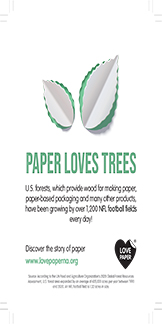Have you heard that the earth is flat, literally flat? Yes, there are serious organizations making impressive-sounding arguments and throwing scientific jargon in every direction to disprove what real science and observation have taught us about our planet, but in the end the earth is still round. So it is with the claim that paper manufacturing is "a major contributor to climate change."
Too many ENGOs and other self-interested parties have invested years trying to refute the findings of global scientific authorities like the Intergovernmental Panel on Climate Change (IPCC) that the paper industry is largely greenhouse gas neutral. But just like the Flat Earth argument, it takes only a little high school science, sound data and a bit of common sense to separate the truth from the blizzard of activist rhetoric posing as climate change "studies."
Biomass in the Forest
In high school science class, we learned about photosynthesis, the process where trees absorb carbon dioxide (CO2) from the atmosphere, and with the help of radiant energy from the sun convert that CO2 into tree fiber called biomass. As trees grow, they continue to remove CO2 from the atmosphere and store it as biomass until they die, decay or are burned, at which time the CO2 simply returns to the atmosphere in a natural carbon cycle. This "biogenic" carbon cycle remains in balance and no net carbon is added to the atmosphere as long as forest carbon stocks - the carbon stored in forest biomass - remain stable or increase.
The biogenic carbon cycle concept is central to globally recognized greenhouse gas inventory and accounting protocols, including the IPCC's Guidelines for National Greenhouse Gas Inventories. As stated in the IPCC's 4th Assessment Report, "In the long-term, a sustainable forest management strategy aimed at maintaining or increasing forest carbon stocks, while producing an annual sustained yield of timber, wood fiber or energy from the forest, will generate the largest sustained [climate change] mitigation benefit."
Are forest stocks in the United States growing? The answer is a resounding "yes," thanks in great part to the sustainable forestry practices and forest certification advocated by the paper industry. The U.S. Forest Service reports that U.S forests grow approximately two times more tree volume than is harvested each year, with net average annual growing forest stock of about 25 billion cubic feet.
Keeping the Carbon Cycle in Balance
It's not unusual for anti-paper activist fundraising campaigns to include photos of a recently harvested plot of forestland, claiming that such harvests have "devastating climate impacts" because it takes decades for replanted or naturally regenerated trees to grow back and replace the carbon that was removed during harvest. While this type of chicanery may be successful in raising money from unwitting individuals and corporations, it completely ignores the science and economics of sustainable forest management.
In the real world, a balanced biogenic carbon cycle is measured across large spatial landscapes and averaged over time, not as a one-time snapshot of a single plot of land. In sustainably managed forests, a balanced carbon cycle is maintained by harvesting trees on some plots which are then regenerated by replanting or natural means, while trees on other plots continue to grow and absorb carbon. In fact, keeping growing forest eco-systems healthy and productive while regenerating areas that have been harvested for paper and other wood-based products (or damaged by forest fires or insects) is the very definition of sustainable forestry. And it takes little more than common sense to understand that sustainable forest management is critical to the paper industry's long-term supply of raw materials, and thus its long-term economic health.
Biomass for Energy
Very little of the sustainably grown wood used in papermaking goes to waste. In addition to the fiber that eventually ends up in paper products, leftovers from the tree harvesting and papermaking processes - things like sawdust, small limbs, bark, and wood residuals from the pulping process - are used to generate renewable energy at U.S. paper mills.
Some in the activist community contend that burning biomass for energy at paper mills is a major contributor to climate change because doing so releases large amounts of CO2 into the atmosphere. While CO2 is released, it is an inherent part of the biogenic carbon cycle and adds no net carbon to the environment. This is significantly different from burning fossil fuels. When fossil fuels are removed from geologic reserves in the ground and burned for energy, this adds carbon to the atmosphere that has been stored for millions of years - essentially new carbon that contributes to climate change.
How much biomass does the U.S. paper industry use to power its operations? The American Forest and Paper Association reports that nearly two-thirds of the energy needs at U.S. pulp and paper mills (64% on average) are met using renewable biofuels, mostly biomass. According to the U.S. Environmental Protection Agency (EPA), displacing fossil fuels with this sustainable bioenergy prevents about 181 million metric tons of CO2 emissions from entering the atmosphere each year. That's roughly equal to removing 35 million cars from the road annually.
Papermaking, Biomass and Climate Change
So how does paper manufacturing fit into the overall picture when it comes to GHG emissions and their impact on climate change? The pulp and paper sector was among the first to take voluntary action to reduce GHGs, so it's no surprise that U.S. paper mills and manufacturing facilities have a solid record of GHG reduction. According to the U.S. EPA's most recent data, emissions from the sector have steadily declined in recent years, down 21% between 2011 and 2021. This reduction is attributed to the increasing use of carbon-neutral biomass fuel, the switch from coal and oil to less carbon-intensive fossil fuels such as natural gas, and technology enhancements that improved overall energy efficiency.
Is paper manufacturing a major contributor to climate change? Contrary to activist claims and pop culture headlines, the answer is clearly, "no," and the data supports this finding. According to the EPA, the U.S. pulp and paper industry is responsible for less than 0.6% of total U.S. greenhouse gas emissions.
For more facts about the sustainability of paper products, click here.






















